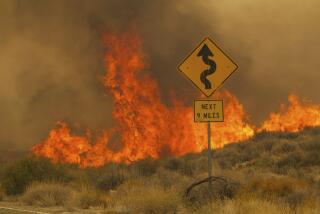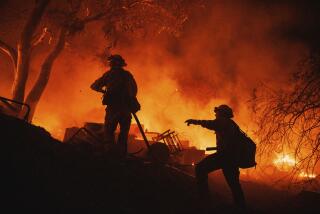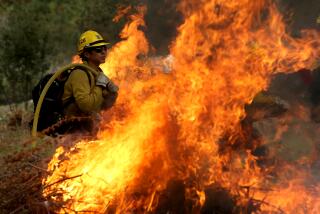Unrelenting winter dryness brings unseasonably high fire risk
California is bracing for what officials fear could be an unprecedented winter fire season fueled by record dry conditions that show no signs of letting up.
January is typically a time when forest fire camps and air bases are closed and seasonal firefighters go home. But not this year. The California Department of Forestry and Fire Protection has responded to 150 wildfires so far. During the same period last January, there were none, and the historic average is 25.
Fire officials pointed to coastal blazes in Humboldt and San Mateo counties in the last two weeks as examples of the conditions they’re facing. The Humboldt fire spread across 333 acres in four days, shocking firefighters because the region is usually damp with rain at this time of year.
“In the winter when we see a fire … it typically will burn at a slow rate of spread. And take an engine to put it out,” said Cal Fire spokesman Daniel Berlandt. “This season, it’s taking a much larger response and even some aircraft because the grass and the brush wants to burn.”
Across California, vegetation that typically rehydrates with rain between December and April continues to get drier and more dangerous. The fires so far this winter have been relatively moderate compared to some of the state’s largest, but officials worry that the fires will get worse as the fuel gets even drier.
“It really is unprecedented. In my career, I’ve not seen this level,” said Cal Fire Director Ken Pimlott. “It’s the first [weeks] of January and we’re seeing conditions that would normally be occurring in midsummer. That’s what we’re up against.”
Forecasters say there is little relief in sight. The National Weather Service last week released a forecast for the southwestern United States calling for unseasonably dry and hot conditions.
William Patzert, a climatologist with the Jet Propulsion Laboratory in La Cañada Flintridge, said California’s historically wet months of February, March and April look bone-dry, and that is going to heighten the fire danger.
“It’s just explosive,” he said. “The grasses are just, they go up like a match… Everything is good to go.”
Patzert said this season’s parched conditions are part of a longer-term weather pattern in the Pacific Ocean called the Pacific Decadal Oscillation.
From the late 1970s to the mid-1990s, the cycle was in a “positive” phase that pushed warm surface water and wet weather to the eastern Pacific. That brought pockets of plentiful rain to California, including infamous El Niño storms. But more recently, the oscillation has trended toward a “negative” phase that’s pushed the wet climate north and east of California.
“If you look at tree rings, these kinds of things have been happening for 1,500 years,” Patzert said. “We don’t really understand why the [change] happens ... but what we do know is that once it happens, it’s persistent.”
Last week’s Colby fire in Glendora demonstrated the dangers. The fire broke out after days of red-flag conditions that brought hot temperatures and winds to parts of Southern California as much of the rest of the country was in a deep freeze.
The blaze started Thursday at 5:51 a.m., quickly consuming four to five acres. Within half an hour, it had burned 100 to 200 acres. Winds pushed the fire and embers at a rapid rate, ultimately burning more than 1,800 acres.
“I’ve never seen a fire move that fast,” said Los Angeles County Fire Deputy Chief David Richardson.
It took more than 1,000 firefighters and extensive use of water-dropping aircraft to contain the flames. Five homes were destroyed and more than a dozen damaged.
“It wouldn’t have been so bad, but with the fuel and the winds, it lined up in perfect alignment and ran down the canyon,” U.S. Forest Service spokesman Nathan Judy said. “It would’ve been a small contained fire we would’ve had out in a few hours.”
Shyi-ren Lin, 54, was among the residents caught off guard by the fire’s rapid march. He spent the past month trimming his trees and clearing brush around his hillside Glendora home but hadn’t completed the work.
He figured he had time: He and his neighbors get letters every February with instructions for required brush clearance and tree-trimming regulations. The deadline is always May 1.
But as the flames crept toward his home Thursday, he had to reconsider life in the hillside canyon.
“I’m thinking, ‘Should I move?’” Lin said. “The danger will grow if we get more dry months and hotter weather. …I think when we live in this area, we should expect the fire could be at any time, not just the dry months, but any time.”
The winter and spring months are generally cooler and less windy than the traditional fall “fire season,” when the hot Santa Ana winds pick up. And weather experts say long-term forecasting is far from precise, so more rain is still a possibility.
But fire departments are staffing as if it is peak season.
Cal Fire has only $20 million of its $152-million emergency firefighting fund left. The agency kept open five of its 11 air bases typically closed in winter. It retained hundreds of seasonal firefighters in Southern California to complement thousands of full-time firefighters.
Officials are frantically trying to bring more than 100 additional seasonal firefighters into Northern California.
“We’re having to really work out scheduling of training and firefighters faster than usual,” Berlandt said. “It’s definitely a difficult job.”
In Sacramento, state budget officials said they are calculating the possibility of an expensive firefighting season into their spending plans.
The fire danger comes as Gov. Jerry Brown on Friday declared a drought emergency and urged residents to cut water use by 20%. Downtown Los Angeles had its driest year on record in 2013.
Some cities in Northern California have already imposed rationing and others are asking residents to eliminate outdoor watering. Water managers in Southern California say they have enough reserves to get through the year and even into 2015 without rationing.
“Firefighters might be able to take showers and water their lawns, but they’re definitely nervous,” Patzert said. “And they should be.”
Times staff writers Ruben Vives and Christine Mai-Duc contributed to this report.
More to Read
Start your day right
Sign up for Essential California for news, features and recommendations from the L.A. Times and beyond in your inbox six days a week.
You may occasionally receive promotional content from the Los Angeles Times.







